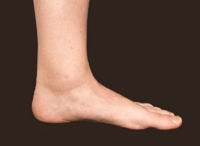Foot
 From Conservapedia
From Conservapedia 
For the unit of measurement, see foot (unit)
A foot is an organ that is used for locomotion and takes a variety of forms depending on the animal.[1] Animal feet are comprised of five fingers or two parts called hooves.
The foot has essentially the same anatomical structure and the same bones in different mammals, but is positioned and used for locomotion in different ways.
Animals with the plantigrade stance, including bears, primates, and armadillos, walk on their entire foot; the whole foot is placed flat on the ground from heel to toe.
Animals with the digitigrade stance, including cats and dogs walk only on the digits of the limbs—corresponding to fingers in humans. The rear part of the foot is lifted off the ground.
Animals with the unguligrade stance, including horses, cattle, and deer, walk only on the tips of the digits. In the horse, the anatomical structure corresponding to the foot is very elongated. In a famous mistake, the lexicographer Samuel Johnson defined the word pastern as "the knee of the horse." The pastern does look like a knee and it in roughly the location where you might expect a knee, but it faces backwards. Animals with the unguligrade stance are fast runners, depending on speed to escape predators, and their legs are long and relatively fragile.
References[edit]
- ↑ Wile, Dr. Jay L. Exploring Creation With Biology. Apologia Educational Ministries, Inc. 1998
Categories: [Anatomy]
↧ Download as ZWI file | Last modified: 02/21/2023 07:55:26 | 48 views
☰ Source: https://www.conservapedia.com/Foot | License: CC BY-SA 3.0
 ZWI signed:
ZWI signed: KSF
KSF